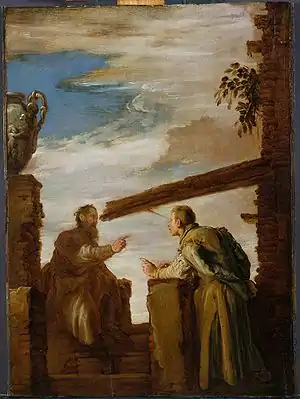The Mote and the Beam
The Mote and the Beam is a parable of Jesus given in the Sermon on the Mount[1] in the Gospel of Matthew, chapter 7, verses 1 to 5. The discourse is fairly brief, and begins by warning his followers of the dangers of judging others, stating that they too would be judged by the same standard. The Sermon on the Plain has a similar passage in Luke 6:37–42.[2]

Narrative
The New Testament text is as follows:
1 Judge not, that ye be not judged.
2 For with what judgment ye judge, ye shall be judged: and with what measure ye mete, it shall be measured to you again.
3 And why beholdest thou the mote that is in thy brother's eye, but considerest not the beam that is in thine own eye?
4 Or how wilt thou say to thy brother, Let me pull out the mote out of thine eye; and, behold, a beam is in thine own eye?
5 Thou hypocrite, first cast out the beam out of thine own eye; and then shalt thou see clearly to cast out the mote out of thy brother's eye.
The first two verses use plural "ye" and "you", and the next three verses use the singular "thou", "thy" and "thine" to the individual. (Luke 6:41 was translated "thou" after using "ye" in Luke 6:37.)
Interpretation
_MET_DP827297.jpg.webp)
The moral lesson is to avoid hypocrisy, self-righteousness, and censoriousness. The analogy used is of a small object in another's eye as compared with a large beam of wood in one's own. The original Greek word translated as "mote" (κάρφος karphos) meant "any small dry body".[3] The terms mote and beam are from the King James Version; other translations use different words, e.g. the New International Version uses "speck (of sawdust)" and "plank". In 21st century English a "mote" is more normally a particle of dust – particularly one that is floating in the air – rather than a tiny splinter of wood. The analogy is suggestive of a carpenter's workshop, with which Jesus would have been familiar.
In the analogy, the one seeking to remove the impediment in the eye of his brother has the larger impediment in his own eye, suggesting metaphorically that the one who attempts to regulate his brother often displays the greater blindness and hypocrisy.
A proverb of this sort was familiar to the Jews and appears in numerous other cultures too,[4] such as the Latin proverb of later Roman days referenced by Athenagoras of Athens, meretrix pudicam.[5]
See also
References
| Wikimedia Commons has media related to Parable of the Mote and the Beam. |
- Matthew by Charles H. Talbert 2010 ISBN 0-8010-3192-3 page 93 view 93
- Steven L. Cox, Kendell H. Easley, 2007 Harmony of the Gospels ISBN 0-8054-9444-8 page 72 view 72
- Henry Liddell and Robert Scott, A Greek-English Lexicon: κάρφος .
- James Hastings (October 2004), "Beam and Mote", A Dictionary of Christ and the Gospels, 1, ISBN 9781410217851 text source
- Generally translated "The harlot rebuketh the chaste", the case-endings obviating the verb
The Mote and the Beam | ||
| Preceded by The Birds of Heaven in the Sermon on the Mount |
New Testament Events |
Succeeded by Discourse on the Two Ways in the Sermon on the Mount |